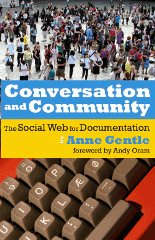We were sent a review copy of Anne Gentle’s book , Conversation and Community: The Social Web for Documentation (www.xmlpress.net). Anne has been a pioneer in developing technical documentation that includes Web 2.0 concepts, so I read it with great interest.

It’s a book that provides practical advice on how to add user generated content to your documentation, as well as how to explain to other departments how this approach complements their objectives. In other words, it looks at documents that allow for conversation, collaboration and aggregation of/about information.
It’s well researched too, with references to many articles, blog posts and software that you’ll want to read. Given this was written in Anne’s spare time, it’s incredibly up to date.
Because we’d been asked to review the book, I read it with a more critical eye than normal:
- It would have been nice if the book had contained a concluding chapter.
- As others have mentioned, there’s an irony in creating a book about conversation without a means to discuss the book.
- Sadly, Cherryleaf’s blog didn’t get a mention in the list of blogs, which means we need to raise our game.
- Adobe Air didn’t get mentioned as a possible solution.
These are minor points, however.
As I said, Anne has been a pioneer in this approach, and there few case studies to draw on. Having said that, Anne has done a really good job at providing examples.
Understandably, not all aspects of this vast subject were covered in the book, so there’s an opportunity for Anne to write a follow up book. I look forward to more debate on these questions and issues:
- Questions over the translation and localisation of user comments still need to be addressed (or will all the users have to write in English?).
- There are also big questions over re-using and re-purposing of content. Anne introduces wiki-slicing and round-tripping of content, but there’s likely to be a big debate about how to integrate user content into a typed (i.e. DITA based), semantic, authoring environment.
- There are issues around introducing collaborative approaches into organisations which have a communication culture of hierarchy, paternalism and/or authority. The open communication approach suits the cultures of open source software and open government, but there are many companies that prefer a more secretive approach. There’s a need to make the economic and business case to these more reluctant organisations.
- We’re also likely to see questions concerning what sort of skills and personality are needed to initiate and maintain an online community. Do technical writers have these skills and the right type of personality? Can they devise and make the business case for a successful social documentation strategy?
- Do we need a technical communication equivalent of “The Cluetrain Manifesto” or even Roald Dahl’s “The rights of the reader”?
Anyway, back to the book. I’d recommend the book to anyone creating user assistance in the many forms it comes in. It’s a very interesting and important subject, and Anne has written a book which anyone involved in this issue will find useful.

Anne’s book is on my wish list. Your questions are very good. Perhaps a wiki will be born somewhere to provide a home to the conversations that will develop in the minds of the readers?
Hi Ellis –
Thanks for this review and the critical eye especially. I talked with a few people about starting a discussion group somewhere around the book, but ultimately I decided the readers should choose where they’d want to start the discussion. Blog comments are a good start, but I’d love a central location. Feel free to suggest a place! The Content Wrangler Community, perhaps? Or, I can start a series of blog posts addressing the items you mention. I have a few others from other readers that I’m writing blog entries about now.
I’d also like to set up a Twitter chat on a specific date and time. Le’s see if that can work across the pond.
And, don’t worry about the lack of mention of your Cherryleaf blog. The list in “Web Resources” is only a list of websites mentioned in the book. So don’t feel like your blog didn’t make the “list” – that’s simply not the case. 🙂
Looking forward to more discussion! Thanks for these great suggestions for revision material.
yeah I didn’t make ‘the list’ either! 🙂
I’ve not finished reading the book yet, but the exciting thing for me is the possibilities and part of embracing such a way of working is to embrace the fear a little and learn how to be a little more reactive as things grow.
Adobe Air as a solution? As it’s a technology it’ll only ever be the technical implementation, not the solution, surely? (yeah ok, I’ll finish reading the book…)
[…] Ellis’s review at Cherryleaf Technical Authors Blog. […]
Thank you for this excellent post. Learning new ideas and thoughts in every author is a great advantages to the soaring writers, and this serves also as their references. I really like the idea of sharing this.
[…] Ellis Pratt’s Review of Conversation and Community: The Social Web for Documentation […]
I’ve put together a gathering page (with a discussion group included) for people who want to talk about the book on Facebook Here’s a shortcut link: http://bit.ly/disAl8. Would love to see you there! 🙂
[…] Review of Conversation and Community: The Social Web for Documentation by Ellis Pratt […]